Beep, beep. I peer over my right shoulder and out the backseat window of my mother’s green Toyota Sienna. Behind the human-size cornstalks, I see my grandmother, waving as she stands at the edge of her garage. She doesn’t walk into the driveway because it’s filled with gravel, and she’s still in her socks.
I can barely see all 4 feet 9 inches and 102 pounds of her behind the cornstalks, but I catch a quick glimpse of her smile and wave before she’s too far out of sight.
As we make our way through downtown Franklin, Indiana—a sleepy kind of place you drive through on the way to somewhere else—I begin to feel my eyes well up. Tears desperately beg to make their way down my cheeks, but I refuse to let them come. I’m 15 years old and can’t bear my parents or twin brother seeing me upset. Aside from a few neighbors, my grandma lives alone in the middle of acres upon acres of farmland. I constantly worry she’s lonely.
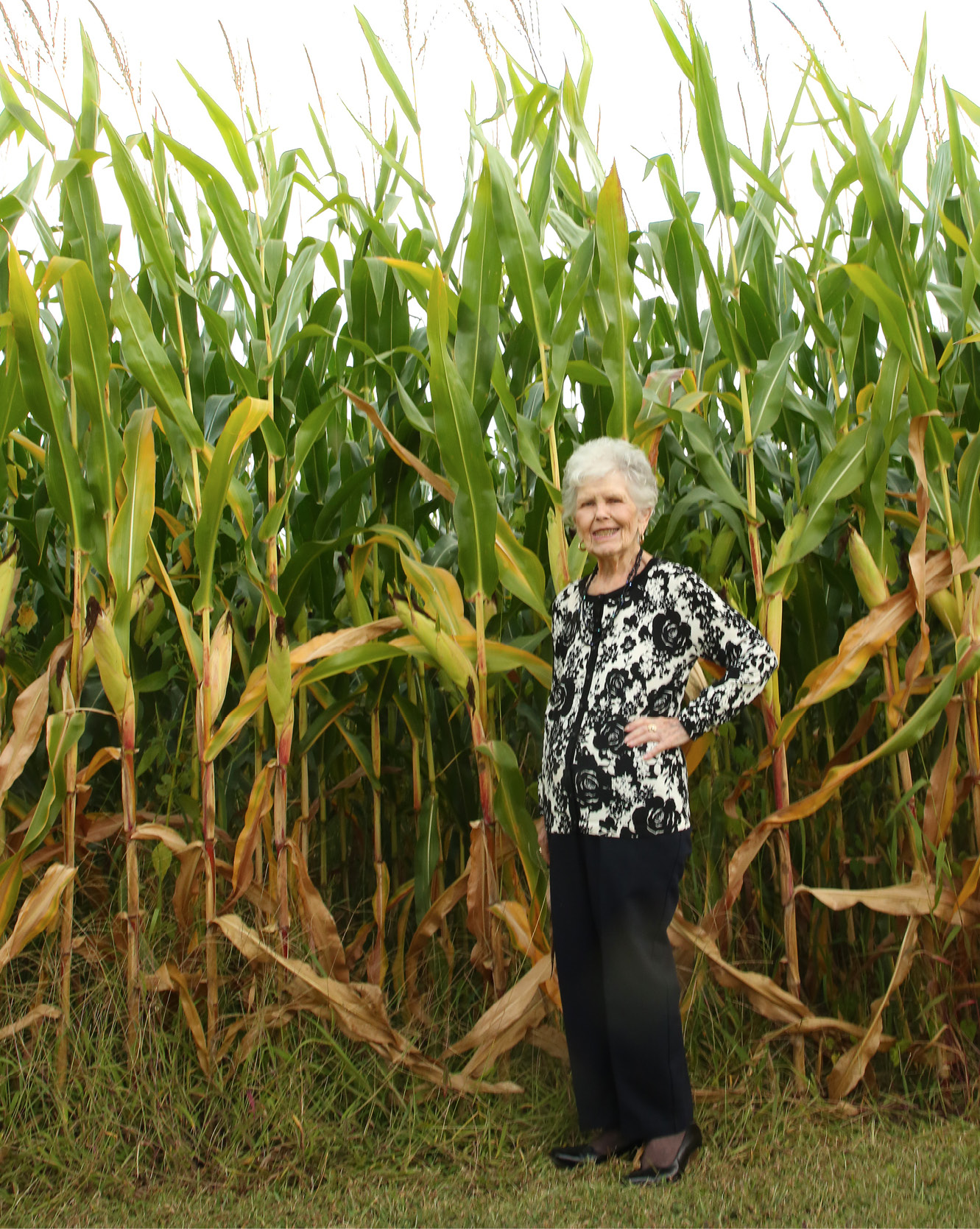
CLAIRE CORBIN
I conjure happy images to fight back the tears—a technique I taught myself as a child. I think of my upcoming trip to Mexico, and the tie-dye party I have planned with my best friend. I focus hard on these happy images, and the tears don’t come.
Related: 10 Clever Tricks to Trigger Positive Emotions
***
I grew up in the northern suburbs of Chicago. My grandmother, Wanda, now 90, lives in southern Indiana, about five hours away. She has a wide smile and thick, white hair that people always tell her is beautiful. She’s physically tiny but emotionally fierce. She speaks with a slight southern Indiana drawl and is deeply liberal. She’s independent and doesn’t ask anyone for anything, but she gives and gives and gives. She loves Elvis Presley more than anyone I’ve ever met. She’s a proponent of tough love. She doesn’t rest and never has.
“You know, Jamie, some days when I wake up, I just want to lie here and be lazy,” she said on the phone a few weeks ago. “I want to sit on the couch and watch TV, but I tell myself I’m not going to do that.”
She’s taught me the importance of never resting—of constantly staying busy and limiting my Netflix binges. She’s taught me to create a purpose for each day. Even if I have a day or weekend free, I always try to do something productive, like hike a long trail or write in my journal, or spend time with someone important to me.
Aside from the occasional Everybody Loves Raymond, Seinfeld or Forensic Files episode, she never sits idly watching TV. If she does have the TV on, she’ll have her latest quilt on a hoop, draped across her lap—needle in, needle out, needle in, needle out—stitching away. Or she’ll be gluing photographs of sunsets taken by my mother onto white notecards to send to friends. Sometimes she plays solitaire on her iPad mini.
People marvel at her physical and mental health. She lives alone in a two-story home, drives and has 20/20 vision. She takes only three medications daily—for her heart, her cholesterol and her blood pressure. Occasionally she’ll ride the Megabus to Chicago to visit us. She still gives her time to the local food pantry and won Senior Volunteer of the Year in Johnson County, Indiana. She worked in the fabric department at Wal-Mart into her 80s because after retiring from teaching, she felt bored and wanted to stay busy.
She went to the neurologist last year because she worried her memory was faltering (despite our telling her she was sharp and had no memory trouble). The neurologist told her she got a nearly perfect score on the Alzheimer’s test, something people 40 years her junior might struggle to do.
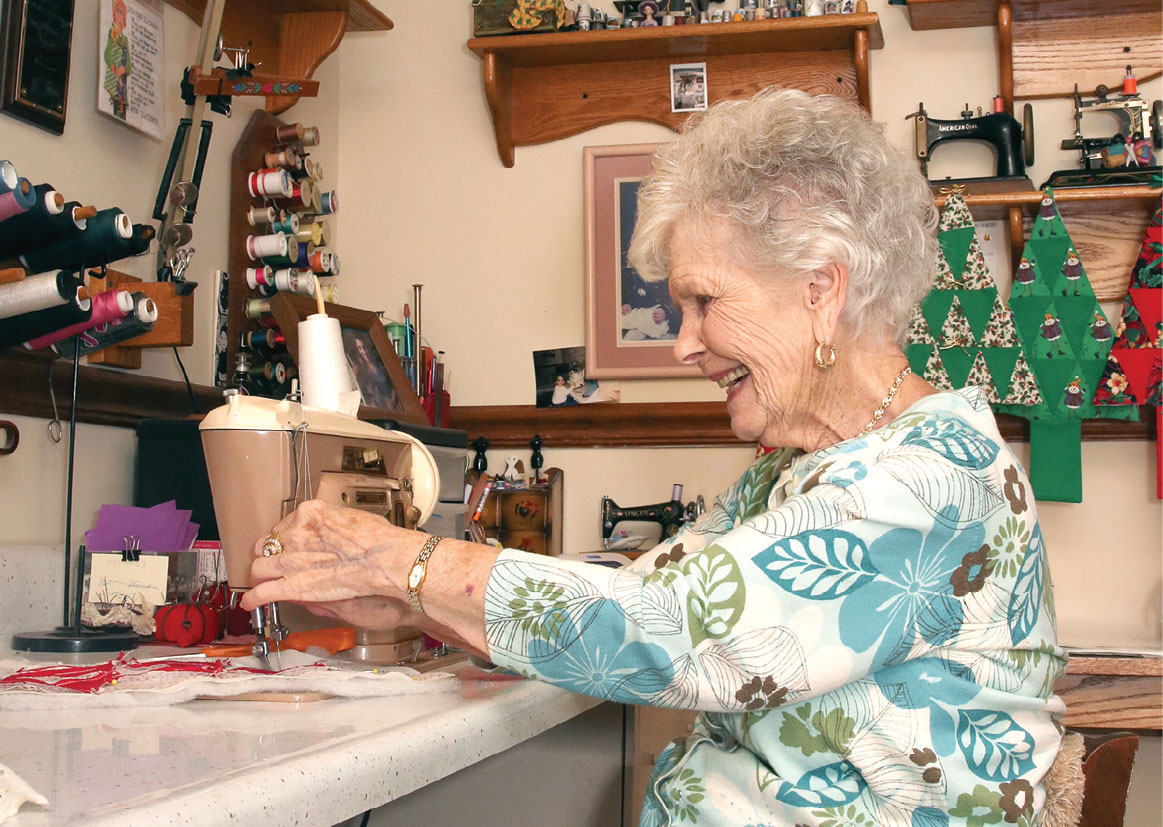
CLAIRE CORBIN
“What’s your secret?” I’ve heard countless people inquire, from the cashier at Cracker Barrel to my husband.
“I really think it’s because I don’t eat much meat,” she says. “And back when I was teaching, I would show up to work early each day and walk 10 laps around the gym.”
After a long chat on the phone recently, I told her I had to go because I had a Pilates class.
“Oh, that’s so good,” she said. “I really should exercise more. I’ve been thinking about walking up and down 400 South to get some exercise each day.” The road in question is right by her house, and smack dab in the middle of cornfields that are at least two feet taller than her. Only a few homes dot the street for miles.
“Some days when I wake up, I just want to lie here and be lazy, but I tell myself I’m not going to do that.”
“Just be careful,” I said.
“I will. You don’t need to worry about me. I’ll have my hearing aids in.”
***
We have a tiny family. My twin brother and I are the only grandchildren. My grandma was born at least a decade after all of her siblings. Her sister, Opal, had a daughter when she was 18 years old, the same year my grandmother was born. She told me she always felt like she had two mothers—her sister and her birth mom. Most of her family members died when she was still young.
She married my late grandfather, Wayne, in the 1940s. They divorced in the 1970s. She worked three jobs to support my mom and aunt through high school and college. She worked during the day as a home economics teacher at the junior high and high school in Trafalgar, Indiana, then at night she picked up shifts serving burgers and ice cream at the local Frosty Queen. She also got her real estate license and sold homes on the side.
My grandma has always led a simple life, but she’s content with it. She has left the U.S. only twice—to teach women to sew in Guatemala and Haiti—and aside from a few road trips to Arizona to visit family, she’s never been one to travel. She’s a self-professed homebody and loves her quiet life in rural Indiana.
Despite some suitors, she never remarried. She prefers independence to companionship, and loneliness rarely takes hold of her. To this day, she says she almost never feels lonely. When I lived alone during graduate school, I tried to channel her independent energy by taking long walks around Chicago or working on a new craft. I turned my occasional loneliness into productivity.
Related: 4 Common Myths About Loneliness
My grandmother’s oldest daughter—my aunt—died from breast cancer in her 40s, when I was 12. Each year, she makes a quilt and donates it to a Relay for Life raffle in honor of my aunt. She has made and donated more than 14 quilts to date and has raised more than $20,000.
My late aunt Debbie is buried on a small hilltop just a half-mile from my grandmother’s home. It’s an old graveyard with just 30 or 40 headstones. Every time I drive by, I peer at the hilltop and see colorful flowers dotting my aunt’s grave. My grandma regularly stops by to clean the stone and put new artificial flowers around it.
She recently told me she reserved the spot next to Debbie. I was immediately taken aback. “Grandma, you shouldn’t talk like that!” I said, clearly uncomfortable talking about death. “That won’t be happening for a very long time.”
She cavalierly brushed off my comment and told me that it was bound to happen one day, so she might as well be ready.
***
By and large, my grandma has escaped loneliness because of her quilting. Two years ago, my graduate school journalism classmate Adam was working on a project, This Is America, in which he created a short video of one person from each of the 50 states. “You have to choose my grandma for Indiana,” I told him. Two days later, he drove down to Franklin, video equipment in tow.
He filmed her in her home, surrounded by her collection of 139 toy sewing machines and hundreds of colorful quilts that she’s both made and bought: the bright yellow yoyo quilt; the rich satin quilt made of my late poppa’s old ties, the log cabin quilt, the postage stamp quilt. She showed Adam her quilts—she’s made around 70 to date—and talked about her quiet life in Indiana, about living alone, about always staying busy.
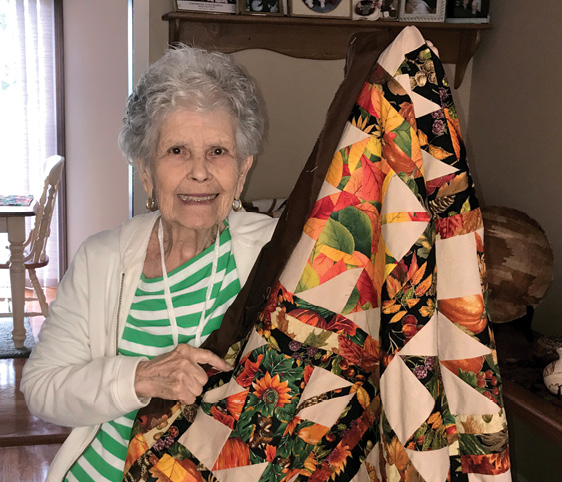
LEESA FRIEDLANDER
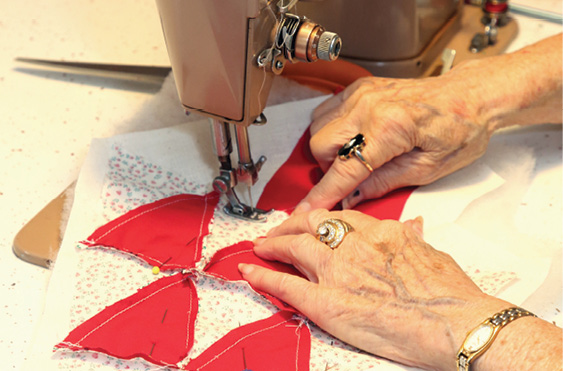
CLAIRE CORBIN
Adam shared the video on Facebook, and my mom and I called each other, giddy with excitement at how many views it was getting. It reached more than 500,000 in just a few days, and it went so viral Business Insider picked it up.
Commenters shared the video and pulled out one of my grandmother’s lines when they did: “My theory is everybody should have a hobby.”
My grandmother’s style of quilting is called hand-quilting. She sews the pieces of fabric together on a machine, and then quilts the intricate designs and patterns that hold the layers of the quilt together by hand. This is largely a dying art, and I’ve met only a few people who still hand-quilt. The lifestyle of many of our elders is fading away as they die—writing in cursive, cooking family recipes from scratch, taking time away from the phone to share a meal and tell stories. Keeping these pursuits alive should be an integral part of our lives—a way to keep our elders close to us as time goes by.
Neither my mother nor my aunt picked up quilting—“probably because they grew up with it constantly,” my grandmother jokes. I’ve always had a passion for intricate things—making jewelry with tiny seed beads and writing lengthy letters by hand—so a few years ago, I decided to give quilting a try. I began with a small wall hanging, then progressed to a gold, navy and red floral quilt. Most recently, I visited my grandmother because I wanted to make a postage-stamp quilt, one made of thousands of tiny mismatched squares of fabric. We blocked off five days for the project.
Related: How to Find Time for Your Passion
I walked into her home, always hovering at a just-too-hot 78 degrees, to see 32 cardboard boxes lined up with 8,000 different squares of fabric inside, each of them one-inch by one-inch—roughly the size of a postage stamp. My grandma has two closets full of old fabric scraps, and she spent weeks sitting on her brown leather couch, Forensic Files on in the background, cutting out these squares for us.
After marveling at the tediousness of her cutting, I followed her upstairs to her sewing room, filled with yellow light from the warm Indiana sun. She had set up two sewing stations—one for me, one for her, side by side. We pinned squares together, then sewed them into long strips, then ironed the strips and repeated, all the while laughing and telling stories. We entered a rhythm so steady five or so hours had passed before we decided it was time for lunch.
We made our way to the kitchen, and I helped her reach something from one of the cabinets. At 5 feet 7 inches, I tower above her.
She told me a story I’ve heard so many times I could recite it by heart.
“My theory is everybody should have a hobby.”
“One time, I asked this man, oh, not much taller than myself, to grab me something on the top shelf at Wal-Mart,” she says, a smile already forming in her eyes. “I swear, he looked so happy I asked him for help. He said, ‘People never ask me to reach things!’ I’m sure I made his day.”
***
Not everyone is so kind to my grandmother, just like not everyone is kind to the elderly. Recently she was driving around Franklin in her silver 2004 Toyota Camry trying to find the house of the woman who distributed the luminaria bags for the Relay for Life.
My grandma got lost and stopped to ask a woman for directions. Several minutes later, she found herself driving by the same woman and asked for directions again, having apparently taken another wrong turn.
“You know, maybe you shouldn’t be driving at your age,” the woman yelled at my grandma.
Conversely, she recently drove to the dentist and mentioned to the receptionist how she got lost on the way. After her appointment, the receptionist insisted she drive to my grandmother’s house and she could follow along in her Camry.
Related: Try These 30 Random Acts of Kindness to Brighten Someone’s Day
The way people treat the elderly varies, but I’ve found it’s a mix of people who infantilize them and say things like, “Oh, you’re so cute,” or people who brush them off, thinking they have nothing to offer. My husband, who works in a hospital, said he can’t count the number of times he’s seen an elderly person with an uninterested family member or no family by their side at all.
And then there are the rare gems, the people who take them as who they are: Complex humans just like the rest of us. My grandma is lucky to be surrounded by gems: my mom, who calls and visits often and is by her side at the drop of a hat; the neighbor who checks in on my grandma the minute we call him; the carpenter friend who makes her anything she needs for her home; the friend who drops by to clean her gutters so she doesn’t have to.
***
I often feel a mixture of remorse and guilt that I don’t get to spend more time with my grandmother. My whole life, I lived just a five-hour drive away, which then turned into a flight from New York, and then a flight from Dallas. My twin brother lived nearby for years while attending college, and then lived with my grandma for six months after a breakup a couple of years ago.
My mom has attempted to convince my grandma to move to Chicago numerous times, but she never agrees. This is her home, she says, and she wants to remain here for the rest of her life.
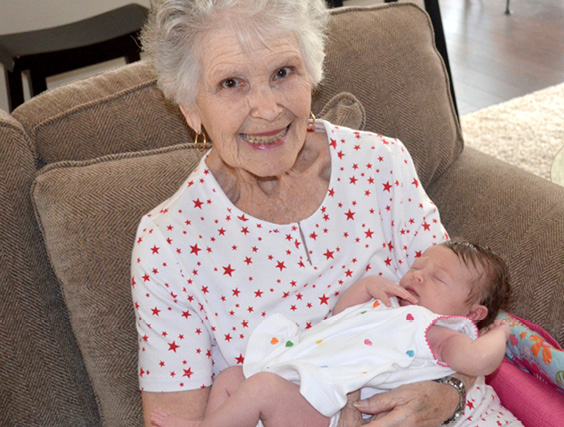
LEESA FRIEDLANDER
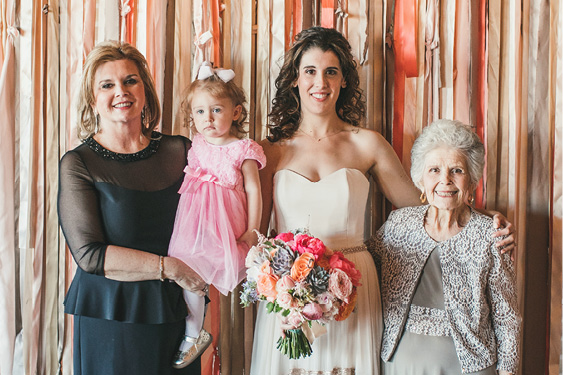
DAVID LAI WEDDINGS
I see her a handful of times a year: Thanksgiving, Christmas, her birthday and occasionally a long holiday weekend. The guilt intensifies with each year and each health scare—the heart attack, the stroke, the dehydration episode that recently sent her to the emergency room, the breast cancer diagnosis two years back. I’ll never forget the sigh of relief we all felt when we heard her surgery went well and she wouldn’t need radiation or chemotherapy.
I wish I could be there to quilt with her on the couch every Sunday, to cook her salmon, to eat the crustless strawberry pie she makes for my brother and me. I wish I could go to the local apple orchard with her each fall, or just on a weekday trip to Jo-Ann, where she’ll spend hours poring through the bolts of fabric. I wish I could get manicures with her and my mom and eat giant meatballs at Buca di Beppo with them afterward.
My time with her is limited and although I have no doubt she’ll live to see an entire century, that’s only 10 more years. I must savor every 45-minute phone call, every handwritten letter I get in my mailbox each week, every email. In fact, she recently emailed me back after I told her how impressed I was at how quickly she finished her last quilt:
“I am known for finishing. Haha.
LOVE. XXXXOOOO
Sent from my iPad.”
I’ve long been of the mindset that the only purpose in life is to love others and to be loved in return. Instead of beating myself up about not getting to see her more, I try instead to focus on how lucky I have been to share so many memories with her. I’ve been able to see her hold her great-granddaughter the day she was born and walk down the aisle at my wedding.
She’s taught me to create a purpose for each day.
I’m reminded of one of my favorite quotes from author Willa Cather’s My Ántonia. “That is happiness; to be dissolved into something complete and great.”
***
I hear the familiar beep, beep as my brother drives away from the gravel road and I roll down my window to wave goodbye to my grandmother. She still stands right at the edge of the garage, her feet in white socks, her pajamas a ribbed gray two-piece set she wears when it’s chilly outside.
I roll up my window and peer out the rearview mirror, her redbrick home now out of sight behind the cornstalks. I’m 27 now, but I feel the same familiar sting in my eyes. I know she’s not lonely and enjoys living by herself. But the sting still comes. The older I get, the tears come not because I picture her sitting at home, lonely, missing us, but rather because when I get back home to my apartment in Dallas, I miss her. Her slow, careful walk from the countless times we’ve all told her to be careful not to fall. Her subtle laugh, often accompanied by a headshake. Her house made of quilts.
As we drive away, her home now out of sight, I employ the same method I’ve used since I was a child. I picture happy things—my recent wedding, my upcoming trip to New York City for work, the way my 2-year-old niece called me “curly Jamie.”
I smile. Some things never change.
Related: 14 Loving Quotes About Family
This article originally appeared in the November 2017 issue of SUCCESS magazine.


